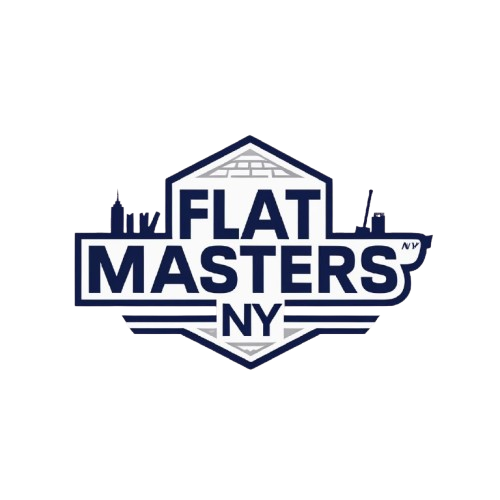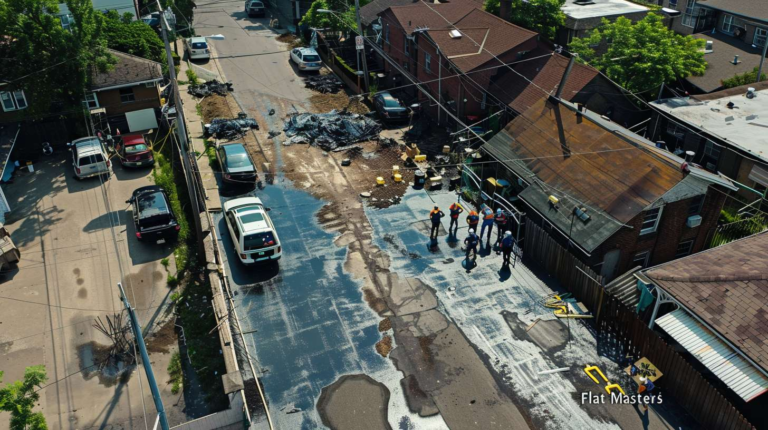Professional Exterior Flat Roof Drainage Services Near You
Look, after 22 years of installing and repairing flat roofs across Queens, I can tell you that exterior flat roof drainage problems cause more headaches than any other roofing issue we see. Just last month on Northern Boulevard, we had to completely redesign a drainage system because the original contractor didn't understand how water actually moves across these roofs.
The thing about flat roofs - and I tell this to every customer - they're not actually flat. They have a slight slope, usually about 1/4 inch per foot, that directs water toward the drainage points. When that external drainage system fails, you're looking at ponding water, structural damage, and interior leaks that can cost thousands to fix.
Why External Drainage Systems Matter More Than You Think
Here's what most property owners don't realize: your flat roof drainage exterior system is doing all the heavy lifting. Internal drains can get clogged with leaves, debris, even tennis balls - I've pulled stranger things out of drains in Astoria. But external systems? They're visible, accessible, and when they work right, they handle water flow like a champ.
We install three main types of exterior drainage on Queens flat roofs: scuppers, gutters, and downspouts. Each has its place depending on your building's design, local weather patterns (and trust me, those nor'easters test every system), and budget.
Scuppers: The Workhorses of Flat Roof Drainage
Scuppers are openings cut through the parapet wall or roof edge that let water drain off the roof. Simple concept, but the installation requires precision. The scupper opening needs to be sized correctly - too small and water backs up, too large and you've weakened your parapet wall unnecessarily.
We typically install scuppers every 75-100 feet along the roof edge, depending on the roof area and expected water volume. Each scupper connects to a leader or downspout system that carries water away from the building foundation. The key is making sure the membrane is properly sealed around each scupper opening - this is where we see most leaks develop over time.
Gutter and Downspout Systems for Flat Roofs
Now, gutters on flat roofs aren't like the residential gutters you see on sloped roofs. These are typically built-in systems integrated with the roof design, or external box gutters mounted along the roof perimeter.
The sizing calculation is critical here. We use the roof area, local rainfall data (Queens gets about 46 inches annually), and building codes to determine proper gutter size and downspout spacing. Undersized gutters overflow. Oversized ones cost more than necessary and can look awkward on smaller buildings.
I always recommend seamless gutters when possible because joints are failure points. Every seam is a place where leaks can develop, especially with the freeze-thaw cycles we get here in New York.
Common Problems We Fix Daily
Clogged drainage is the number one call we get. Leaves, paper, even plastic bags blow onto these roofs and block the drainage points. That's why we always install leaf guards and debris screens on our external systems.
Improper slope is another big issue. The roof needs to slope toward the drainage points, but sometimes settling occurs, or the original installation was done incorrectly. We can fix slope issues with tapered insulation systems or by adjusting the drainage locations.
Ice dams cause problems too, especially on buildings with poor insulation. When snow melts and refreezes at the drainage points, water backs up on the roof. We address this with heating cables at critical drainage areas and improved building insulation recommendations.
Installation Process and Timeline
Installing a new exterior flat roof drainage system typically takes 2-4 days for most Queens buildings, depending on the roof size and complexity. We start with a detailed survey of the existing roof, checking the slope, membrane condition, and structural capacity for new drainage components.
The actual installation involves cutting openings (if needed), installing scuppers or gutter systems, connecting downspouts, and ensuring proper membrane sealing around all penetrations. We test every system before we leave - running water through the entire drainage path to verify proper flow and check for leaks.
Material Choices That Actually Matter
For scuppers, we primarily use aluminum or galvanized steel. Aluminum resists corrosion better in our coastal environment, but steel is stronger for larger openings. The choice depends on your specific situation and budget.
Gutter materials include aluminum, steel, and copper. Copper looks great and lasts forever, but it's expensive. Aluminum is the sweet spot for most commercial buildings - good performance, reasonable cost, widely available.
All our drainage components are sized according to local building codes and manufacturer specifications. We don't cut corners on sizing because undersized drainage leads to water damage, and oversized systems waste money.
Maintenance Requirements
External drainage systems need regular maintenance, but it's straightforward stuff. We recommend cleaning debris from scuppers and gutters at least twice yearly - spring and fall. Check for ice buildup in winter and clear it if necessary.
Inspect the membrane sealing around drainage penetrations annually. Small cracks can be sealed with compatible roofing cement, but larger issues need professional attention.
Downspouts should be checked for proper attachment and alignment. High winds can loosen connections, and settling can cause misalignment that affects drainage performance.
At Flat Masters NY, we service what we install. Our maintenance programs keep these systems functioning properly year after year, protecting your investment and preventing costly water damage. We know Queens buildings, we understand local weather patterns, and we install drainage systems that work reliably in our climate.
Need help with your flat roof drainage? Call us at (917) 994-7618. We'll assess your current system, recommend improvements if needed, and provide straight answers about what will work best for your building and budget.


